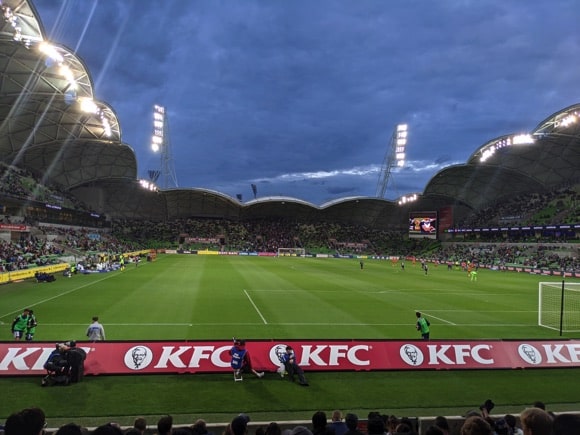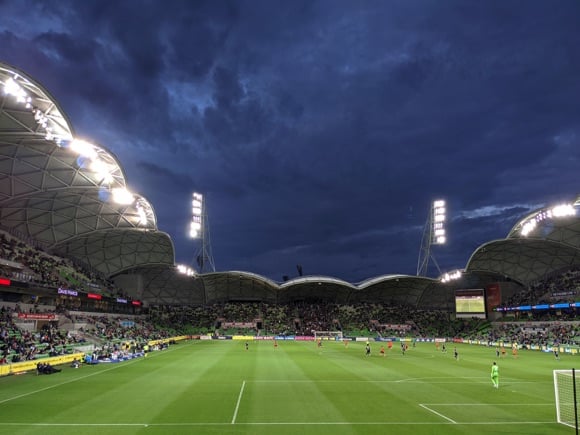The field of dreams – and the story behind it
Going by its sponsored name of AAMI Park to followers of rival local clubs Melbourne Victory and City, the Melbourne Rectangular Stadium stands alongside the former Olympic Park Stadium it replaced in 2010.
Until then, this training venue for the 1956 Games at the nearby MCG was the main soccer ground in Victoria State.
Apart from the final and bronze-medal game, Olympic football tournament was played out here, top stars of the USSR, Yugoslavia and Bulgaria seeing off the likes of India, Indonesia and a British amateur XI. Reigning champions Hungary, of course, withdrew in the wake of the failed 1956 Uprising at home.
Shortly before the Games, at the Australian National Championships, top middle-distance runner, Melbourne-born John Landy, missed the chance to set a new world record for the mile here as he stopped to help up a young Ron Clarke who had fallen on the track – a moment of sportsmanship captured in statue form by the stadium.
You’ll also see a likeness of Peter Norman, the silver medallist at the 200 metres race of 1968, after which he stood in solidarity with US athletes John Carlos and Tommie Smith who gave the Black Power salute. Nearly 40 years later, the pair gave eulogies at his funeral in Melbourne. Look out, too, for the statue of Hungarian football legend Ferenc Puskás, who led South Melbourne to the National Soccer League title in 1991.




The Olympic Park Stadium continued to focus on athletics, rugby league and soccer, the men’s national side failing to score against Scotland side here before the 1986 World Cup.
By the early 2000s, the ground had been superseded by the Docklands, aka Marvel, Stadium twice its size, ideal for soccer, rugby and (mainly) Aussie rules. Melbourne Victory moved here in 2006, along with Australia’s men’s and women’s teams for selected internationals.
Now redundant, the Olympic Park Stadium was demolished in 2012 and replaced by the Olympic Park Oval, a training ground for venerable Aussie rules side Collingwood.
Alongside now rose the Melbourne Rectangular Stadium, purpose-built for both codes of rugby and soccer. Soon renamed AAMI Park after a long-term sponsorship deal with an insurance company, the 30,000-capacity became instantly recognisable thanks to the cluster of see-through domes that make up its roof, allowing maximum sunlight onto the turf.
On their outer cover, pin-pricks of LED lights create a memorable sight set beneath the starlit sky – this is an atmospheric place to watch a game of football, inside and out.




Melbourne Victory set the highest attendance record for a sporting event here, 29,843 for the (successful) A-League Grand Final against great rivals Sydney FC in 2015 – although the MCG was the original choice of venue. That same year, this was one of five stadiums to co-host the 2015 AFC Asian Cup, although only used for group games and one quarter-final.
While Melbourne Victory’s women’s team, 2022 A-League champions also call the stadium home, followers of the men’s have earned the arena no little notoriety. Regular trouble by fans on the North Terrace on the Olympic Side led to extra security presence, which in turn led to protests and violent scenes. While the groups who earned the most raucous part of the stadium its unenviable reputation have long been disbanded, the creation of Original Style Melbourne shortly before the pandemic revived this ultra culture.
Across the pitch, while City’s Yarraside at the south, river end of the ground decided to fold in protest over the rebranding of their club from Melbourne Heart in 2014, many of their old followers remain.
Matters came to a head in December 2022 when both sets of fans in the Melbourne derby showed their displeasure at the staging of six upcoming A-League Grand Finals in Sydney. Sponsorship money from New South Wales had persuaded Australia’s soccer authorities to end the tradition of this showcase event being hosted by the team that had finished highest in the table during the regular season.



Halfway through the first half, with Victory and City fans throwing flares onto the pitch, the referee abandoned the match, causing an invasion and a metal bucket to be thrown at City goalkeeper Tom Glover. Victory supporters were duly banned from away games, and home gates plummeted with the restriction of admission to members only. City followers, meanwhile, boycotted the subsequent Grand Final here at their own ground.
As a non-partisan stage for major occasions such as the Women’s World Cup, however, the Melbourne Rectangular Stadium is a very impressive venue indeed, with perfect sightlines from all four stands, up close to the action so you can smell the turf and hear the players’ shouts. The upper tiers of both long sideline stands offer a loftier view, the noise echoing beneath those geodesic domes that also provide shelter for all.
Ironically, they are also part of the long-term problem here – stuck with a relatively modest capacity of 30,000, the Melbourne Rectangular Stadium cannot be expanded without significant change to the roof, perhaps even removing it altogether.
Until then, marquee fixtures are usually hosted at the MCG, Docklands Stadium or, worse, in Sydney. For the Women’s World Cup, the MRS hosted two Round of 16 matches – but no quarter-final or semi. As if to redress the balance, in November 2024, AAMI Park was chosen to host the vital men’s World Cup qualifying game between Australia and Saudi Arabia.



getting here
Going to the stadium – tips and timings


Melbourne’s network of trams, buses and metropolitan trains runs on an integrated top-up ticket, myki. Within the Central Business District (CBD), trams are free. All 6 metropolitan train lines serve the main stations of Southern Cross and Flinders Street. The next stop is Richmond, near the Olympic Park complex.
Regular tram 70 interlinks Flinders Street, the nearby Fan Festival at Federation Square – both within the fare-free tram zone – and Olympic Park a short hop away, including 7C-John Cain Arena/Melbourne Park, 7D-Olympic Boulevard and Richmond.
To reach the stadium in style, a water taxi can be sailed down the Yarra to the Southgate Landing by Flinders Street. For an extra A$12 when there’s a major event on, it runs to the landing platform by the Rod Laver Arena in the Olympic Park complex.
Where to Drink
Pre-match beers for fans and casual visitors






By the rail lines near Richmond station, the Corner Hotel at 57 Swan Street is a major live venue and popular bar/restaurant, open from noon but closed on Mondays. Beers currently including 4 Pines Japanese Style Lager, Mountain Goat Steam Ale and Balter XPA, best imbibed on the rooftop garden.
Across the tracks, the Precinct Hotel at 60 Swan Street is more mainstream but more attuned to big-screen sport, also offering live acoustic shows and DJs at weekends. It shares its history with Richmond station opposite, opening as the Greyhound in 1862, three years after the depot itself.
Back towards the MCG, the equally historic Cricketer’s Arms at 327 Punt Road dedicates a whole upper floor to pool and TV sport, big screens also set up around the modest main bar. Open on days of sports events at the Melbourne Rectangular Stadium, and from Wednesdays through Sundays.






